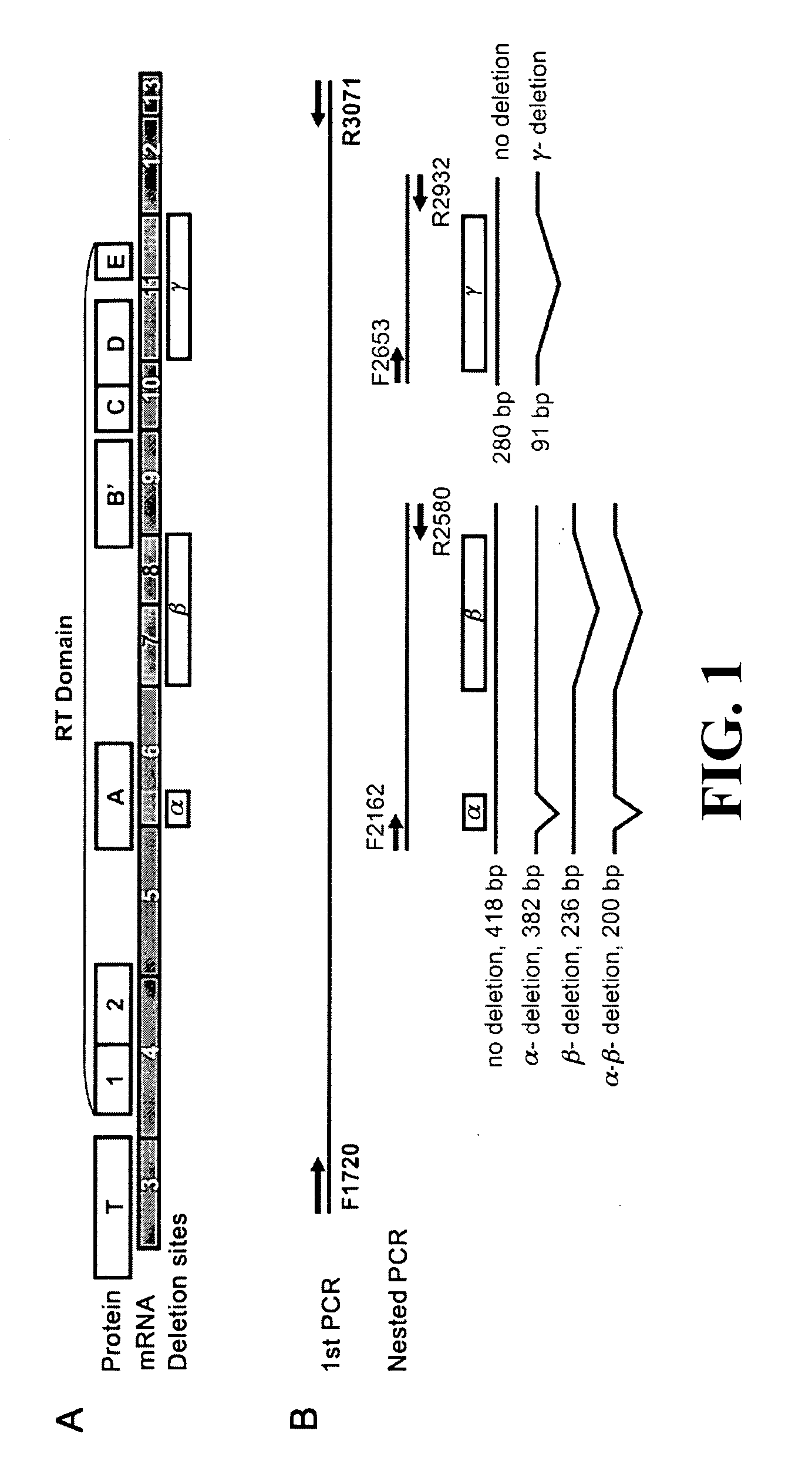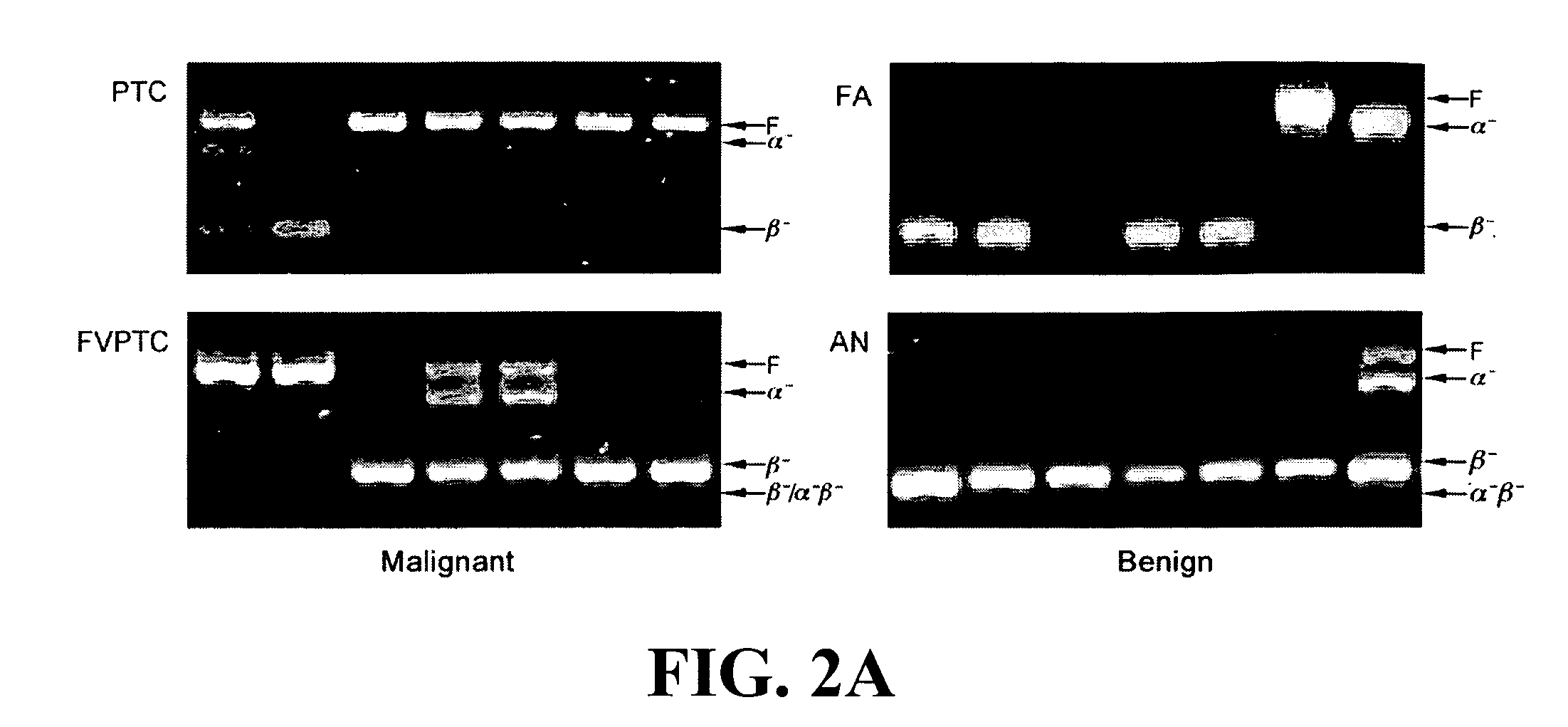ALTERNATIVE SPLICE VARIANT PATTERNS OF HUMAN TELOMERASE REVERSE TRANSCRIPTASE (hTERT) IN THYROID TUMORS TO DISTINGUISH BENIGN FROM MALIGNANT
a technology of telomerase reverse transcriptase and human telomerase, which is applied in the field of alternative splice variant patterns of human telomerase reverse transcriptase (htert) in thyroid tumors, can solve the problems of indeterminate or suspicious 20-30, patients with suspicious thyroid lesions cannot be optimally managed, and clinicians and patients are placed
- Summary
- Abstract
- Description
- Claims
- Application Information
AI Technical Summary
Benefits of technology
Problems solved by technology
Method used
Image
Examples
example i
Materials And Methods
[0084]A. Tumor tissues
[0085]One hundred and thirty three thyroid tumors were collected under Johns Hopkins Institutional Review Board approval from patients undergoing thyroid surgery. Samples included 60 malignant (28 papillary thyroid cancers, 24 follicular variant of papillary thyroid cancers, 5 follicular cancers, and 3 Hürthle cell cancers) and 73 benign lesions (31 adenomatoid nodules, 21 follicular adenomas, 12 Hürthle cell adenomas, and 9 Hashimoto's thyroiditis nodules). Follicular and Hürthle cell cancers are relatively infrequent thyroid tumors resulting in the limited sample numbers. Samples were snap frozen in liquid nitrogen and stored at −80° C. until use. Among these 133 samples, a subset of 50 tumors had suspicious FNA cytology reports.
B. RT- And Nested PCR
[0086]Total RNA was isolated from each tumor with Trizol (Invitrogen, Carlsbad, Calif.) and purified with RNeasy Mini Kit (Qiagen, Valencia, Calif.). Reverse transcription was performed with 1...
example ii
Results of Studies of hTERT Alternative Splice Patterns
[0091]A. hTERT Alternative Splice Variant Patterns In Thyroid Tumors
[0092]hTERT gene expression was detected in 114 of the 133 (86%) thyroid tumors (Table 1).
TABLE 1Thyroid Tumors Analyzed for hTERT alternative splice variant patterns by subtypeMalignant (n = 60)Benign (n = 73)FVPTCFAANHAPTC(n =FCHC(n =(n =(n =LcTFinal Histology(n = 28)24)(n = 5)(n = 3)21)31)12)(n = 9hTERT positive282131212569(n = 114)hTERT full-length24 (86%)4 (19%)3 (100%)1 (100%)1 (5%)1 (4%)4 (67%)3 (33%>0.33a (n = 41)aAn hTERT full-length expression cut point of 0.33 corresponded to a specificity of 0.85 and a sensitivity of 0.60.AN, adenomatoid nodule;FA, follicular adenoma;FC, follicular carcinoma;FVPTC, follicular variant of papillary thyroid carcinoma;HA, Hürthle cell adenoma;HC, Hürthle cell carcinoma;LcT, lymphocytic thyroiditis nodule;PTC, papillary thyroid carcinoma indicates data missing or illegible when filed
[0093]No tumor exhibited a γ-deletion ...
example iii
Identification of Other Splice Variants Associated With Malignant Or Non-Malignant Thyroid Tumors
A. Splice Array Analysis
[0105]Twenty one thyroid tumors were analyzed by splice array analysis. Three each of papillary thyroid cancer, follicular variant of papillary thyroid cancer, follicular cancer, adenomatoid nodule, follicular adenoma, Hürthle cell adenoma, and lymphocytic thyroiditis nodule, plus corresponding normal thyroid samples were hybridized to Human Genome Wide SpliceArray™ (ExonHit Therapeutics, Inc., Gaithersburg, Md.) on the Affymetrix platform.
[0106]In brief, the splice array analysis was carried out as follows:
[0107]Transcript amplification and labeling: Amplified, labeled cDNA was prepared using the NuGEN WT-Ovation™ Pico RNA Amplification System and the FL-Ovation™ cDNA Biotin Module V2. First strand cDNA was prepared from total RNA using a unique first strand DNA / RNA chimeric primer mix and reverse transcriptase (RT). The primers have a DNA portion that hybridizes...
PUM
| Property | Measurement | Unit |
|---|---|---|
| Tm | aaaaa | aaaaa |
| temperature | aaaaa | aaaaa |
| temperature | aaaaa | aaaaa |
Abstract
Description
Claims
Application Information
 Login to View More
Login to View More - R&D
- Intellectual Property
- Life Sciences
- Materials
- Tech Scout
- Unparalleled Data Quality
- Higher Quality Content
- 60% Fewer Hallucinations
Browse by: Latest US Patents, China's latest patents, Technical Efficacy Thesaurus, Application Domain, Technology Topic, Popular Technical Reports.
© 2025 PatSnap. All rights reserved.Legal|Privacy policy|Modern Slavery Act Transparency Statement|Sitemap|About US| Contact US: help@patsnap.com



